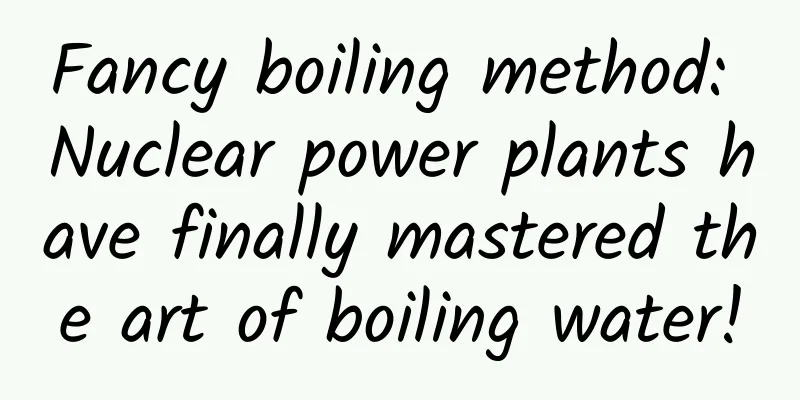Fancy boiling method: Nuclear power plants have finally mastered the art of boiling water!

|
Produced by: Science Popularization China Author: Science Scraps (Popular Science Creator) Producer: China Science Expo Nuclear power plant, you should be familiar with this term, but do you know how it works? Let the energy release slowly How do nuclear power plants convert nuclear energy into electrical energy? First of all, we have to talk about nuclear fission reactions . Nuclear fission is a reaction in which a heavy atom's nucleus splits into two lighter nuclei after being hit by a neutron. In this process, some byproducts are often generated at the same time, such as several neutrons and additional energy. When nuclear fission reactions occur in uranium-235 and plutonium-239, the neutron energy released is often relatively high. Such neutrons are called fast neutrons , and their speed can reach 5% of the speed of light. Uranium-235 fission reaction (Image source: wikimedia) Because of their fast speed, these neutrons can continue to collide with uranium or plutonium nuclei in a short period of time, triggering more nuclear fission. This series of reactions is the familiar chain reaction. This is very important when an atomic bomb explodes. Only when as many chain reactions as possible occur in the shortest possible time can the atomic bomb exert its great power. But in the nuclear reactor of a nuclear power plant, the situation is different. Nuclear power plants do not want to release nuclear energy quickly in a short period of time. The most important thing is to output them gently and stably . Therefore, in the nuclear reactors of most nuclear power plants, there are moderators to slow down fast neutrons and turn them into more efficient slow neutrons (or thermal neutrons) . Using this energy, nuclear power plants can boil water, and then use the generated steam to drive the blades of the steam turbine, which in turn drives the generator to generate electricity. This achieves the purpose of converting nuclear energy into electrical energy. Several different types of nuclear reactors Different types of nuclear power plants have slightly different ways of boiling water. Let's start with the two most common types of nuclear reactors, which are boiling water reactors and pressurized water reactors. Earlier we mentioned that something needs to be added to the nuclear reactor of a nuclear power plant to slow down fast neutrons. In fact, ordinary water can be used as a neutron moderator, and water is also a good coolant, so these two types of reactors use water as a neutron moderator and coolant. However, there are some differences between the two reactors. The boiling water reactor is relatively "simple and crude". It simply puts water and nuclear fuel in a container. After the nuclear fuel boils the water, the water directly turns into steam to drive the turbine. Boiling Water Reactor (Image source: wikimedia) The pressurized water reactor is a little more complicated. The pressurized water reactor has two circuits, called the primary circuit and the secondary circuit. In the primary circuit, the water is also placed directly together with the nuclear fuel, and the water is heated to 200-300 degrees Celsius here (the primary circuit is in a high pressure state, so even if it exceeds 100 degrees Celsius, the water will not boil). Pressurized Water Reactor (Image source: wikimedia) These hot water will transfer heat to the secondary circuit through pipes. Note that these water will not enter the secondary circuit, but only transfer heat to the secondary circuit . In the steam generator of the secondary circuit, the water is boiled and turned into steam, which then drives the steam turbine. Both types of nuclear reactors have advantages and disadvantages. For example, compared with boiling water reactors, pressurized water reactors include primary and secondary circuits, which are longer and involve more equipment. In the primary circuit, water needs to be maintained at a high pressure, and the technical performance requirements and cost are often higher. The water vapor in a boiling water reactor is in direct contact with the core and has a relatively high radiation level. Both its transmission link and the entire link in contact with the steam turbine need to be well protected against radiation. Our country's technology for building pressurized water reactors is at the world's leading level, and most of our operating nuclear power plants are also pressurized water reactors. In addition, our country's self-developed "Hualong One" unit is also a pressurized water reactor. At present, "Hualong One" has been exported to Pakistan, and the United Kingdom and Argentina are also actively introducing "Hualong One" units. Heavy water reactor Whether it is a boiling water reactor or a pressurized water reactor, there is ordinary water in them. We know from junior high school chemistry that water is composed of two hydrogen atoms and one oxygen atom, and its molecular formula is H2O. But hydrogen actually has two isotopes, deuterium and tritium. Adding one more neutron to the nucleus of a hydrogen atom turns it into deuterium (adding two more neutrons turns it into tritium). Deuterium and oxygen atoms can also form water molecules, namely D 2 O. This water is much heavier than ordinary water, so it is called heavy water. Heavy water, like ordinary water, can also be used as a coolant and moderator for nuclear reactors, and it has a natural advantage over ordinary water. Although ordinary water can be used as a neutron moderator, it also absorbs some neutrons. This requires that the uranium-235 in the raw materials of nuclear reactors must reach a relatively high concentration. Heavy water (D2O) (Image source: wikimedia) In contrast, heavy water absorbs neutrons much less than ordinary water. This makes it unnecessary to enrich uranium-235 to a very high concentration, and even natural uranium oxide can be used directly as the core material, thus skipping the step of enriching uranium . Our country's Qinshan Phase III Nuclear Power Plant is the country's first commercial heavy water reactor nuclear power plant. Fast breeder reactor The three types of nuclear reactors mentioned above all convert fast neutrons into thermal neutrons to trigger chain reactions. So are there any nuclear reactors that directly use fast neutrons? Of course there is. Such a nuclear reactor is called a fast neutron breeder reactor , or fast reactor for short. Fast neutrons can react with uranium-238, causing it to undergo β decay and become plutonium-239, which can continue to be used as fuel for nuclear reactions, so it is called a breeder reactor . Our country's independently developed experimental fast reactor (CEFR) was connected to the grid and generated electricity in July 2011. In addition, our country's demonstration fast reactor also started construction in December 2017. China's Experimental Fast Reactor under construction (Image source: wikimedia) In addition, there are gas-cooled reactors and small modular reactors. Nuclear energy is also providing energy for mankind in a more gentle way, and with the update of technology, nuclear reactors are becoming safer and more reliable. References: [1] National Nuclear Safety Administration: Are all nuclear power plants of the same type? 【2】International Atomic Energy Agency: Water-Cooled Reactor 【3】International Atomic Energy Agency: Fast Reactor [4] Charles D. Ferguson, Nuclear Energy (Oxford Popular Science Reader), Huazhong University of Science and Technology Press |
<<: China's sea! The sea breeze brings the "taste" of 5G!
>>: "Fighting Family" "Color Master"? How come the mantis shrimp in your mouth can do everything?
Recommend
Can seasonal infusion prevent cerebrovascular disease? It's really unnecessary! There are risks...
gossip Every year when the seasons change, many e...
In unison, why are BAT collectively imitating LeEco's ecosystem?
In 2014, "ecosystem" became a fashionab...
Android source code download: APP startup guide
Functional classification: Tools Supported platfo...
A magical journey: Oil's autobiography, My legend part 2
Ancient life came from the vast ocean and returne...
How much is the price for being an agent of Shiyan Toy Mini Program? Shiyan Toys Mini Program Agent Price Inquiry
How much does it cost to be an agent of a toy min...
Learn about the magic of ants! Ants not only herd livestock, but also grow mushrooms
Produced by: Science Popularization China Author:...
4 key points of e-commerce product operation
In addition to the North Star Indicator, which is...
Run a lucky draw in 6 steps and double your Weibo followers!
Lucky draw activities are an important tool for i...
2019 Marketing Promotion Hotspot Calendar (Practical Collection)
Without further ado, the "2019 Marketing Hot...
What are the functions of the Lanzhou Auto Mini Program? How much does it cost to develop a WeChat car mini program?
In 2021, China's car ownership will reach 350...
Why do onions, ginger and garlic have such magical powers to remove fishy smell and enhance fragrance?
Key Points ★ The flavor substances emitted from o...
Google advertising types and independent website operation skills
When it comes to off-site promotion, the first th...
How to use the KOLs at hand to make a good New Year’s greetings compilation? Share some tips
With the New Year being such a hot topic, every o...
“Meituan Takeout” product analysis report!
Take-out has become a must-have for urbanites, sa...
What is a virtual world, and can it really be lived in?
Author: Duan Yuechu The virtual world is a fascin...









